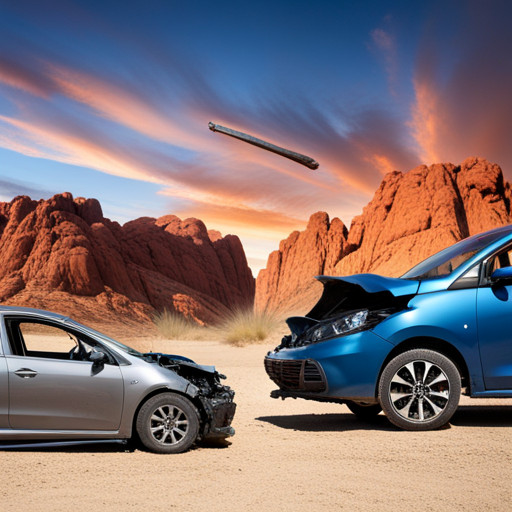Arizona Car Accidents Laws Fault Compensation and Insurance
This article explores the legal complexities surrounding car accidents in Arizona.

Emphasis is placed on the state's traditional fault-based system, the role of comparative negligence, and the statute of limitations for lawsuits.
The importance of comprehensive insurance coverage and its impact on compensation claims is also examined.
A clear comprehension of these factors is essential for anyone navigating the aftermath of a vehicular incident in Arizona.
Key Takeaways
- Arizona follows a traditional fault-based system for liability in car accidents, where the person at fault is financially responsible for the resulting harm.
- Arizona has a two-year deadline for filing most car accident lawsuits, and failing to file within this deadline will likely result in the court refusing the lawsuit.
- Arizona allows for compensation for all types of losses in car accident cases, including medical treatment, pain and suffering, and financial harm.
- Arizona follows a pure comparative fault rule, where the damages award is reduced by the percentage of fault, even if the plaintiff is more responsible for the accident.
Understanding Arizona Car Accident Laws

Understanding Arizona Car Accident Laws necessitates a comprehensive grasp of several key regulations. These include the two-year deadline for filing lawsuits and the statutory requirement to report accidents. Additionally, it is important to understand the application of the statute of limitations to all personal injury cases.
Arizona car accident reporting requirements mandate prompt notification to law enforcement for any accident resulting in bodily harm, death, or significant property damage. Appreciating the significance of these requirements is critical, especially when navigating the aftermath of an accident.
The two-year deadline constitutes Arizona's statute of limitations in car accident cases. This period commences from the date of the accident, and its expiry precludes the possibility of legal recourse. Therefore, a thorough understanding of this timeframe is indispensable for potential litigants.
Reporting Requirements After a Car Accident in Arizona

In the event of vehicular incidents within the state, there is a legal obligation to promptly report the matter, as specified by the relevant regional regulations. This underpins the importance of Arizona Car Accident Reporting and the associated legal reporting obligations in Arizona Car accidents.
1. Any driver involved in an accident in Arizona, resulting in injury, death, or property damage, must report the incident to the local police or sheriff's department.
2. Failure to report the accident can result in the suspension of driving privileges.
3. The report should include accurate information about the incident, such as date, time, location, and details of all parties involved.
4. The Arizona Department of Transportation maintains all accident reports, which are accessible to involved parties upon request. This ensures accountability, transparency, and adherence to state regulations.
The Role of the Statute of Limitations in Car Accident Cases

Strict adherence to the statute of limitations is crucial when filing lawsuits related to vehicular incidents, as any delay beyond the specified two-year deadline could lead to the court declining the case. This underscores the importance of timely filing in car accident cases.
| Statute of Limitations | Importance | Consequences |
|---|---|---|
| Two-year deadline | Ensures timely filing | Missing the deadline can lead to case dismissal |
| Covers personal injury, vehicle damage, wrongful death claims | Applies to a wide range of lawsuits | Filing late may forfeit the right to legal recourse |
| Strictly enforced by Arizona courts | Reinforces the rule of law | Negligence in understanding the deadline can lead to loss of potential compensation |
| Key to Arizona car accident lawsuits | Sets the legal timeline for filing | Consequences of missing the statute of limitations deadline are severe |
| Legal requirement | Cannot be bypassed or extended arbitrarily | Failure to adhere can compromise the entire legal process |
This emphasizes the need for understanding the consequences of missing the statute of limitations deadline.
Determining Fault in Arizona Car Accidents

Determining liability in vehicular incidents requires an examination of the circumstances surrounding the event, with the party found to be responsible typically bearing the financial burden of resultant damages. In the state of Arizona, this process of determining fault utilizes a traditional fault-based system.
1. The individual deemed at fault is held financially accountable for the resulting harm.
2. The insurance carrier of the at-fault driver is responsible for covering losses up to the limits of liability coverage.
3. Comparative negligence, a principle followed in Arizona, allows for a reduction of the damages award by the percentage of fault attributed to the plaintiff.
4. Even if the plaintiff is found to hold a majority of the responsibility for the accident, the comparative fault rule still applies.
How Arizona’s Traditional Fault-Based System Works

Understanding the workings of the traditional fault-based system is imperative, as it dictates the allocation of financial responsibility in vehicular incidents. In Arizona, this system is utilized to determine liability in car accidents. The party deemed at fault is financially accountable for the resulting harm. The at-fault party's insurance carrier bears the responsibility of covering losses up to the liability coverage limits stipulated in their policy.
It is therefore crucial to comprehend the limits of one's liability coverage to gauge potential financial risk. This traditional fault-based system contrasts with no-fault systems, which are not adopted in Arizona, making the process of proving fault a key component in car accident cases within the state.
This understanding of liability allocation is fundamental in navigating the aftermath of vehicular incidents.
The Important Role of Proving Fault in Car Accident Cases

In vehicular collision cases, the establishment of culpability plays a critical role, as it directly impacts the allocation of financial liability and the potential for recompense. The process of proving fault is paramount, particularly in jurisdictions like Arizona that operate under a traditional fault-based system.
Evidence is vital in establishing fault. It may include police reports, eyewitness testimonies, and photographic or video evidence from the accident scene.
The role of expert testimony, such as accident reconstruction specialists, can provide compelling evidence on the dynamics of the collision.
The importance of proving fault cannot be understated as it directly influences the compensation that the injured party may receive.
In situations where comparative negligence is applicable, the degree of fault attributed to each party will proportionately reduce the damages awarded.
Types of Compensation Available After a Car Accident in Arizona

Victims of vehicular collisions may be eligible to recover a broad spectrum of damages, encompassing medical expenses, pain and suffering, lost wages, and the impact on their future earning capacity.
The process of recovering lost wages, a critical component of compensation, involves proving the victim's inability to work and the subsequent income loss. This may require medical documentation and employment records.
Additionally, victims can seek compensation for property damage. This typically involves an assessment of the vehicle's pre-accident value, cost of repairs, and depreciation due to the collision.
It is crucial to understand that Arizona's comparative negligence law may reduce the compensation if the victim shares some blame for the accident.
The Impact of Arizona’s Comparative Negligence Rule on Car Accident Cases

The rule of comparative negligence significantly influences the outcome of vehicular collision cases, as it allows for the apportionment of blame and adjustment of damages accordingly. This rule has a profound impact on car accident cases in Arizona. It dictates that if an injured party is partially to blame for the accident, the damages awarded will be reduced by their percentage of fault.
Four key points to consider include:
1. The role of fault in determining compensation in Arizona car accident cases is paramount.
2. A plaintiff's percentage of fault directly influences the compensation awarded.
3. Even if a plaintiff is more than 50% at fault, recovery is still possible under Arizona's pure comparative negligence rule.
4. This rule makes it critical for all involved parties to accurately establish fault.
How Comparative Negligence Affects Damages in Car Accident Cases

Comparative negligence plays a critical role in adjusting the amount of damages awarded in vehicular collision cases, thus affecting the final compensation received by the plaintiff. In Arizona, this rule operates as a mechanism to apportion the responsibility based on the role of plaintiff's negligence. This directly impacts the damages calculation, thereby modulating the compensation. The table below provides a simplified illustration:
| Percentage of Plaintiff's Negligence | Total Damages | Final Compensation |
| 10% | $10,000 | $9,000 |
| 50% | $10,000 | $5,000 |
| 90% | $10,000 | $1,000 |
As evident from the table, the higher the percentage of plaintiff's negligence, the lower the final compensation. Therefore, an accurate determination of comparative negligence is of utmost importance in ensuring a fair damages award.
Arizona’s Car Insurance Requirements Explained

After dissecting the influence of comparative negligence on compensation in car accident cases, the focus shifts to the Arizona car insurance requirements. As a critical element in understanding the legal framework of operating a motor vehicle in the state, these requirements stipulate the minimum coverage limits that must be adhered to.
In Arizona, every motorist must have liability insurance with minimum coverage of $25,000 for bodily injury or death of one person, $50,000 for bodily injury or death of two or more persons, and $15,000 for property damage in any one accident.
Uninsured and underinsured motorist coverage is not mandatory but recommended.
Full coverage, although not required, is advisable especially for newer vehicles.
Understanding these insurance policies is crucial as they play a significant role in any claim following a car accident.
Thus, insurance coverage is not just a legal requirement but a protective measure for Arizona drivers.
The Importance of Car Insurance in Arizona Car Accident Cases

Understanding the significance of adequate coverage in motor vehicle collision cases proves integral, as it often dictates the financial outcomes for involved parties. The role of car insurance in Arizona car accident cases cannot be understated, as it serves as a primary source of financial compensation for accident victims.
Arizona, being a fault-based state, mandates the at-fault party's insurance to cover the losses up to the liability coverage limits. Therefore, the importance of insurance coverage in car accident claims is paramount.
In cases where the at-fault driver's insurance is insufficient, the victim may resort to their own coverage, underinsured motorist coverage, to compensate for the shortfall. Hence, understanding and maintaining appropriate insurance coverage can significantly affect the financial restitution in car accident cases in Arizona.
Frequently Asked Questions
What Are the Steps to Take Immediately After a Car Accident in Arizona?
Following an automobile collision in Arizona, emergency preparedness is crucial. Immediate actions should encompass ensuring safety, contacting emergency services for any injuries, and reporting the incident to law enforcement.
It is also essential to document accident details meticulously, including photographs of the scene, vehicle damage, and any injuries sustained. Gathering witness information, if applicable, and notifying the insurance company at the earliest instance is also recommended.
How Can I Protect My Rights Following a Car Accident in Arizona?
To safeguard rights following a car accident in Arizona, it is essential to take certain steps. These steps include documenting the incident meticulously and managing post-accident communication effectively.
One important aspect of documentation is gathering evidence. This can include taking photos of the accident scene, any damages to the vehicles involved, and any visible injuries. It is also important to record details of the incident, such as the date, time, and location of the accident, as well as the names and contact information of any witnesses.
Obtaining medical reports is also crucial for documenting injuries sustained in the accident. This can help establish the extent of the injuries and their impact on the victim's life.
Managing communication is another key aspect of safeguarding rights. This involves interacting with other parties involved in the accident, such as the other driver(s) and their insurance companies. It is important to be cautious about what information is shared, as disclosing too much information could potentially be used against the victim in legal proceedings.
Additionally, it is important to communicate effectively with one's own insurance company and any legal representatives involved. This ensures that the victim's rights are protected and that they receive the appropriate compensation for their injuries and damages.
Is It Necessary to Hire a Lawyer for a Car Accident Case in Arizona?
In considering legal representation for an Arizona car accident case, factors such as legal fees evaluation and settlement negotiation strategies become pivotal.
An attorney's expertise can aid in precisely assessing legal costs and effectively negotiating for a fair settlement. These professionals can navigate the complexities of Arizona's fault-based system, comparative negligence rule, and insurance requirements, potentially maximizing compensation.
Therefore, securing legal representation may be advantageous in such cases.
How Long Does an Insurance Company Have to Settle a Claim in Arizona?
In Arizona, insurance companies generally have a period of 30 days to acknowledge receipt of a claim. After acknowledgment, claim investigation should be completed within 40 days.
While these timelines are standard, settlement delays can occur due to various reasons such as complexity of the case, need for further investigation, or dispute on liability.
Therefore, claim timelines can vary significantly based on the specifics of the individual case.
Can I Sue the Car Manufacturer if a Faulty Part Caused the Car Accident in Arizona?
In Arizona, product liability laws permit lawsuits against car manufacturers if a faulty part caused a car accident. This falls under manufacturer negligence, holding the producer responsible for defective products. If a plaintiff can prove the part was defective and this defect led to the accident, they may successfully claim damages.
However, the statute of limitations must be adhered to, requiring such lawsuits to be filed within two years of the accident.

This post has been generated by AI and was not reviewed by editors. This is Not legal advice. Please consult with an attorney.




